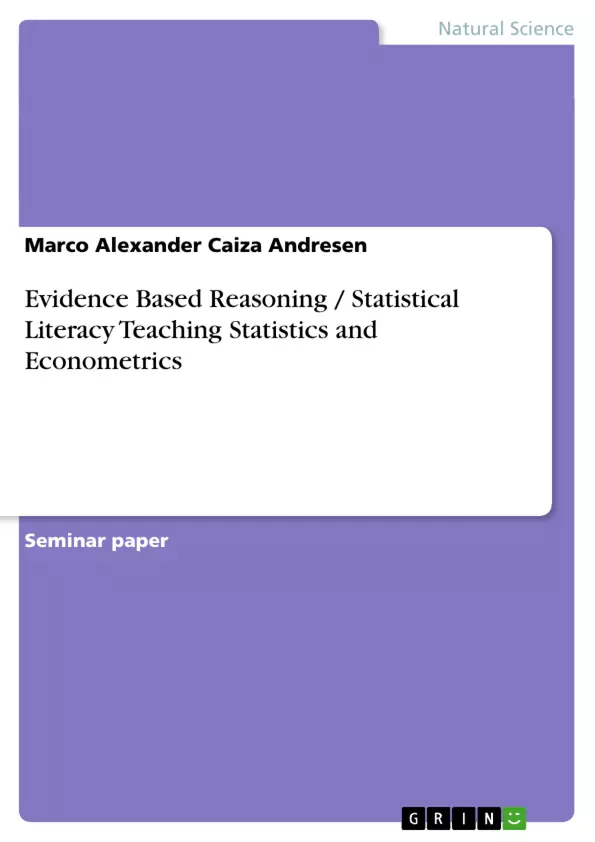Outdated education models, technological advances and increasing enrollment of students have led to involve Web-based education in some economics classes of various universities. The options range from Web-based applications in traditional classes to complete online courses without any face-to-face contact. Two facts are stressed with special regard to statistics and econometrics classes in this paper. These are, firstly, the problems tutors have to teach students the essential contents of the courses (this refers also to many aspects of economic undergraduate courses) and, secondly, the problems tutors face to find the right way to teach by using the possibilities the technological advance offers to education methods. Given that only a few written sources on teaching statistics and econometrics exist and having in mind that econometrics is part of the economics education, articles regarding research in overall economic education will also be analyzed in this paper. Due to the latest articles the aim of the paper is to compare and combine the findings of different studies carried out in order to find the best way of teaching econometrics and statistics. After a short introduction the main part of the paper gives an overview of the conventional way of teaching statistics and econometrics and indicates the problems involved. This is followed by a section on new initiatives in the education of econometrics and statistics. Thereinafter, three forms of teaching – traditional (off-line) instruction, hybrid Internet-based instruction and Internet-based instruction – will be dealt with to see in how far the proposed initiatives already have been applied on the subjects. In the last part a conclusion is drawn to summarize the main findings and to show the direction of future teaching in this field. As it already became clear in the headline subject matter of this paper is the aspect of teaching and not learning; the work deals exclusively with the perspectives of the teaching institutions and not of those on the receiving end of the instruction.
Inhaltsverzeichnis (Table of Contents)
- I. Introduction
- 1.1 Purpose of the Paper
- II. Main Part
- 2.1 Main Problems in Teaching Statistics and Econometrics
- 2.2 New Initiatives in Teaching Statistics and Econometrics
- 2.3 Models of Teaching Statistics and Econometrics
- 2.3.1 Traditional Instruction
- 2.3.2 Hybrid Internet-Based Instruction
- 2.3.3 Internet-Based Instruction
- 2.3.4 Comparison of the Three Models
- III. Conclusion
Zielsetzung und Themenschwerpunkte (Objectives and Key Themes)
This paper aims to compare and combine findings from different studies on the best way to teach econometrics and statistics. It examines traditional teaching methods and explores new initiatives in this field, focusing on the use of technology in education.
- Challenges and limitations of traditional methods in teaching statistics and econometrics
- New initiatives and advancements in teaching statistics and econometrics, particularly the integration of technology
- Comparison and analysis of different teaching models, including traditional, hybrid, and internet-based instruction
- Evaluation of the effectiveness and feasibility of these teaching models in practice
- Future directions and considerations for teaching statistics and econometrics in light of technological advancements and changing educational needs
Zusammenfassung der Kapitel (Chapter Summaries)
- Introduction: This chapter introduces the topic of teaching statistics and econometrics in the context of evolving education models and the increasing use of Web-based learning. It highlights the challenges faced by educators in conveying essential concepts and finding suitable teaching methods in a technologically advancing environment. The chapter also outlines the paper's purpose and structure, indicating the focus on teaching perspectives and excluding learning aspects.
- Main Problems in Teaching Statistics and Econometrics: This chapter examines the difficulties encountered in traditional teaching approaches for statistics and econometrics. It highlights the limitations of traditional methods, including the lack of practical applications, abstract and dry textbooks, and the reliance on unrealistic numerical examples. The chapter also emphasizes the importance of real-world applications, active learning techniques, and incorporating current events into the curriculum.
- New Initiatives in Teaching Statistics and Econometrics: This chapter explores new initiatives and trends in teaching statistics and econometrics, focusing on the integration of technology. It examines different approaches to utilizing technology, including the use of software tools, online resources, and collaborative learning platforms. The chapter discusses the potential benefits of these initiatives for both students and instructors, emphasizing improved student engagement, enhanced learning experiences, and increased access to resources.
- Models of Teaching Statistics and Econometrics: This chapter delves into three distinct teaching models: traditional (offline) instruction, hybrid Internet-based instruction, and Internet-based instruction. It provides an overview of each model, examining their strengths, weaknesses, and suitability for different learning environments. The chapter concludes with a comparison of the three models, highlighting key differences in terms of delivery, resources, and student interaction.
Schlüsselwörter (Keywords)
The key topics and concepts explored in this paper include: teaching statistics, econometrics, educational models, traditional instruction, hybrid instruction, internet-based instruction, technology integration, real-world applications, active learning, student engagement, and future trends in education.
- Arbeit zitieren
- Diplom-Kaufmann, M.A. Marco Alexander Caiza Andresen (Autor:in), 2006, Evidence Based Reasoning / Statistical Literacy Teaching Statistics and Econometrics, München, GRIN Verlag, https://www.grin.com/document/73336



